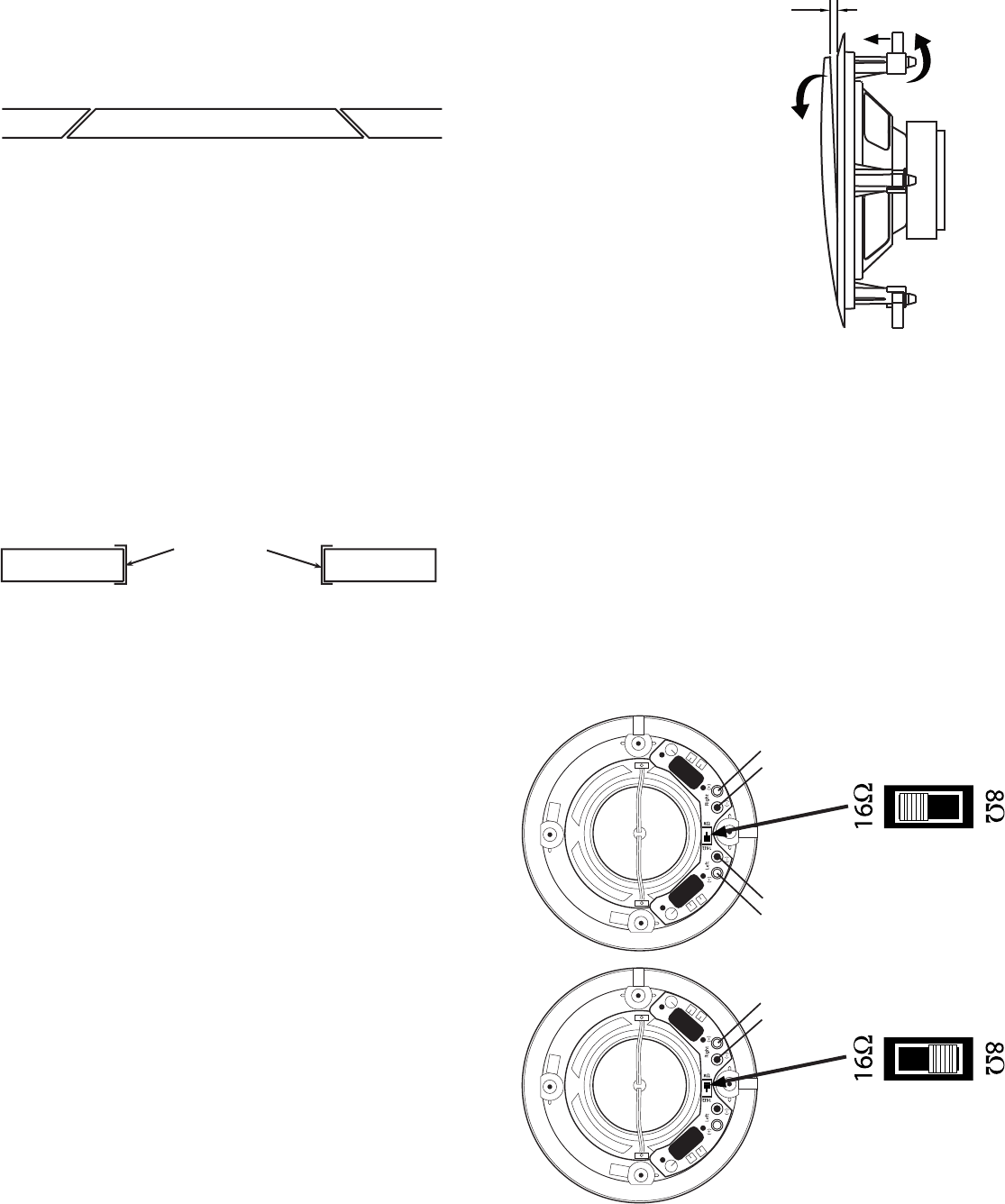
After selecting the mounting location, mark the hole to
be cut out. A template is provided in the speaker box.
Locate and align the template, then mark with pencil
on the ceiling surface. If you are unsure whether there
are obstructions behind the ceiling surface where the
speakers are to be mounted, cut a small hole in the
center of your marked mounting location. Holding your
drywall saw at a 45 degree angle (See Figure 1), cut a
square hole that you can use to locate any obstructions,
should they exist.
The 45 degree wedge shape of the removed surfacing
material will make replacement, if necessary, a much
easier task and yield a better finish when patching the
work.
Once it has been determined that there are no obstruc-
tions, cut the hole to mount the speaker using the drywall
saw at a 90 degree angle to the ceiling surface. Cover
the raw edges of the wallboard with masking tape
(See Figure 2). This will prevent the back pressure of the
speaker from blowing loose gypsum dust out and onto
the painted ceiling surface after installation. Do not allow
the tape to extend more than 1/4” beyond the edge of the
hole into the room. The frame of the speaker will cover
and hide the tape.
Next run your speaker wire to your speaker locations.
A UL rated CL3 speaker wire is recommended when
running wire inside your walls. In many areas it may
be required by code. When running your speaker wire
you should avoid having the speaker wire run parallel
to the 120V power lines to avert picking up hum and
interference from the power service. If the speaker
wire needs to cross a 120V power line at a right angle
this is acceptable and will not create a problem.
If you are uncomfortable with running the speaker wire
yourself in existing construction, it is recommended that
you retain a qualified custom home installation specialist
or electrician.
Installing the Speaker
Installation Tip! To further enhance the performance
of your ATC-DM speaker, the ceiling joist cavity where
you plan to place your speaker can be stuffed with a
generous quantity of fiberglass insulation. Stuff the area
in front of and behind the speaker opening with 6” thick
insulation to a depth of approximately 2 feet beginning
1 foot in front and 1 foot behind the speaker opening. If
the insulation is foil or paper backed, face the backing
away from the ATC-DM speaker. The addition of this
insulation will help prevent unwanted transfer of sound
into the otherwise large and resonant cavity of the un-
ROOM
Figure 2
ROOM
Masking T.ape
Figure 1
insulated ceiling.
It is now time to connect the speaker wire to the speaker.
Your speaker wire is usually coded to identify each
conductor as either positive or negative. This can be
by color coding, or one conductor may have a printed
marking or at least a rib along one edge that you will not
find on the other. Identify which type of polarity coding
that your wire is using. You must carefully observe that
the positive terminal of the speaker output on your
amplifier is connected to the positive terminal of the
ATC-DM speaker. Likewise, the negative terminal of the
amplifier’s speaker output should be connected to the
negative terminal of the ATC-DM speaker (Figure 4).
2
Grill Removal for Installation
CAUTION! The grill is held in place by contact pressure
around the edges where it attaches to the speaker frame.
To avoid difficulty reinstalling the grill, care should be taken
to not distort its shape
while removing it.
While looking at the rear
of the speaker assembly,
rotate two of the adjacent
mounting clamps outward
and then evenly press them
towards the grill. The clamp
screws contact the inner
surface of the grill, pushing
it gently out of its mounting
groove (Figure 3). Only lift
the grill 1/4" (6mm) at this
location. Next use the other
mounting clamps to further
loosen the grill. Use care to
not distort the grill shape.
1/4"(6mm)
Figure 3
(+) Amp
(-) Amp
(+) Amp
(-) Amp
(R)
(L)
Caution! If the ATC-DM is set to 8Ω with two
amplifier channels connected, amplifier damage
will occur.
Only Right or Left
Channel is
Connected
(Conventional
Speaker)
Connecting the Speaker
Right and Left
Channels are
Both Connected
(Summed
Mono Speaker)
Figure 4
(+) Amp
(-) Amp
(R or L)






